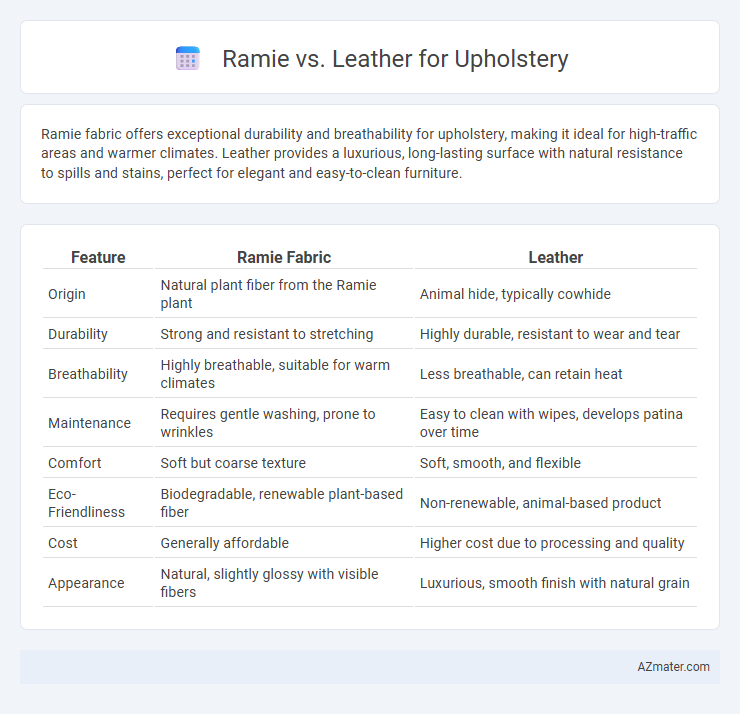Ramie fabric offers exceptional durability and breathability for upholstery, making it ideal for high-traffic areas and warmer climates. Leather provides a luxurious, long-lasting surface with natural resistance to spills and stains, perfect for elegant and easy-to-clean furniture.
Table of Comparison
| Feature | Ramie Fabric | Leather |
|---|---|---|
| Origin | Natural plant fiber from the Ramie plant | Animal hide, typically cowhide |
| Durability | Strong and resistant to stretching | Highly durable, resistant to wear and tear |
| Breathability | Highly breathable, suitable for warm climates | Less breathable, can retain heat |
| Maintenance | Requires gentle washing, prone to wrinkles | Easy to clean with wipes, develops patina over time |
| Comfort | Soft but coarse texture | Soft, smooth, and flexible |
| Eco-Friendliness | Biodegradable, renewable plant-based fiber | Non-renewable, animal-based product |
| Cost | Generally affordable | Higher cost due to processing and quality |
| Appearance | Natural, slightly glossy with visible fibers | Luxurious, smooth finish with natural grain |
Introduction to Ramie and Leather Upholstery
Ramie upholstery, made from natural vegetable fibers derived from the Ramie plant, offers exceptional durability, breathability, and resistance to pests and mildew, making it an eco-friendly alternative for sustainable furniture. Leather upholstery, crafted from processed animal hides, provides unmatched luxury, strength, and ease of maintenance while developing a unique patina over time, which enhances its aesthetic appeal. Both materials present distinct advantages in texture, longevity, and environmental impact, influencing their suitability for various interior design applications.
Material Origins: Ramie and Leather Explained
Ramie upholstery fabric is derived from the fibers of the Boehmeria plant, a natural bast fiber known for its silky luster and durability. Leather, on the other hand, originates from the hide of animals, primarily cattle, and undergoes tanning processes to enhance strength and longevity. Both materials offer unique textures and sustainability profiles, with ramie being plant-based and biodegradable, while leather provides a luxurious, long-lasting surface with natural breathability.
Sustainability and Environmental Impact
Ramie, a natural fiber derived from the nettle plant, offers a highly sustainable alternative to traditional leather in upholstery due to its biodegradable properties and low water usage during cultivation. Leather production involves significant environmental concerns, including high greenhouse gas emissions, deforestation for cattle ranching, and chemical-intensive tanning processes that contribute to water pollution. Choosing ramie over leather reduces carbon footprint and supports eco-friendly interior design by minimizing reliance on animal agriculture and harmful manufacturing techniques.
Durability and Longevity Comparison
Ramie upholstery offers impressive durability due to its strong natural fibers, making it resistant to wear and tear, while leather provides exceptional longevity with its ability to develop a patina that enhances its appearance over time. Ramie's resistance to abrasion and resistance to mold and mildew make it suitable for high-traffic areas, whereas leather's toughness and ease of maintenance contribute to its long-term performance even under heavy use. Both materials deliver outstanding durability, but leather generally outperforms ramie in lifespan, often lasting decades when properly cared for.
Comfort and Texture Differences
Ramie upholstery offers a breathable and lightweight texture with a natural luster, providing a cool and comfortable seating experience ideal for warm climates. Leather, in contrast, delivers a smooth, supple surface that becomes more comfortable over time as it softens and molds to the body, though it can feel warmer and less breathable. The choice between ramie and leather hinges on the balance between natural fiber softness and leather's durable, luxurious feel.
Maintenance and Cleaning Requirements
Ramie upholstery boasts high durability with minimal maintenance, requiring only regular vacuuming and occasional spot cleaning using mild detergent to prevent fiber damage. Leather demands more intensive care, including periodic conditioning to maintain its suppleness and specialized cleaners to avoid cracking or discoloration. Both materials benefit from prompt stain removal, but ramie's natural resistance to moisture makes it more forgiving in high-traffic or humid environments compared to leather.
Aesthetic Appeal and Design Versatility
Ramie fabric offers a natural, textured aesthetic with a matte finish that complements rustic and eco-friendly interiors, while leather provides a sleek, polished look ideal for modern and luxurious designs. Ramie's breathable fibers allow for a variety of dyeing options and patterns, enhancing design versatility, whereas leather's smooth surface supports embossing and patina development, adding character over time. Both materials cater to distinct stylistic preferences, making them suitable for diverse upholstery projects based on desired ambiance and durability.
Cost Analysis: Ramie vs Leather
Ramie upholstery is significantly more cost-effective than leather, with prices averaging $10 to $20 per yard compared to leather's $50 to $150 per square foot. Ramie offers affordability for large projects due to lower raw material and processing costs, while leather incurs higher expenses from tanning and finishing processes. Choosing ramie reduces upfront investment but may require more frequent replacement, whereas leather's durability justifies its premium price over time.
Best Applications for Each Material
Ramie fabric excels in upholstery for eco-friendly furniture and lightweight, breathable seating due to its natural fiber strength and moisture-wicking properties, making it ideal for warmer climates and casual living spaces. Leather upholstery is best suited for high-traffic areas and luxury furniture, offering durability, easy maintenance, and a sophisticated look, especially in formal settings or spaces requiring long-lasting materials. Choosing ramie supports sustainability and comfort, while leather prioritizes elegance and resilience in upholstery applications.
Choosing the Right Upholstery: Key Considerations
Ramie offers a sustainable, breathable fabric option with a natural sheen and high durability, making it ideal for eco-conscious upholstery projects, whereas leather provides a luxurious, easy-to-clean surface with excellent wear resistance suited for high-traffic areas. When choosing the right upholstery, factors such as fabric durability, maintenance requirements, aesthetic preferences, and environmental impact play crucial roles. Consider the specific use case, room ambiance, and allergen sensitivity to determine whether the natural fibers of ramie or the classic appeal of leather better meet your upholstery needs.

Infographic: Ramie vs Leather for Upholstery
 azmater.com
azmater.com